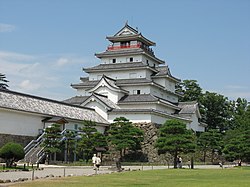Aizu
This articleneeds additional citations forverification.(July 2009) |
Aizu
Sẽ tân | |
|---|---|
 Tsuruga Castle,located inAizuwakamatsu | |
 Aizu comprises the western third ofFukushima Prefecture | |
| Country | Japan |
| Prefecture | Fukushima |
| Area | |
| • Total | 5,420.69 km2(2,092.94 sq mi) |
| Population (1 October 2017[1]) | |
| • Total | 270,648 |
| • Density | 50/km2(130/sq mi) |



Aizu(Sẽ tân)is the westernmost of the three regions ofFukushima Prefecture,Japan,the other two regions beingNakadōriin the central area of the prefecture andHamadōriin the east. As of October 1, 2010, it had a population of 291,838.[2]The principal city of the area isAizuwakamatsu.
It was part ofMutsu Province;the area once was part ofIwase Provincecreated during the reign ofEmpress Genshō.[3]TheYōrōRitsuryoestablished the Iwase Province in 718 through the division of the Michinoku Province (Mutsu Province). It was composed of five districts of Shirakawa ( Bạch Hà ), Iwase ( thạch bối ), Aizu ( sẽ tân ), Asaka ( an tích ) and Shinobu ( tin phu ). The area encompassed by the province reverted to Mutsu some time between 722 and 724.
During theEdo period,Aizu Domain(Sẽ tân phiên,Aizu-han)was afeudal domainunder theTokugawa shogunatewhich ruled most of the region fromAizuwakamatsu Castle.[4]Following theMeiji restoration,it became part of the short-livedIwashiro Provincebefore becoming a region of Fukushima Prefecture.
Although never an official province in its own right, Aizu has a very strong regional identity.
Notable people
[edit](Listed Alpha betized by Last Name/First Name in the Japanese convention for clarity)
- Akizuki Teijirō(1824–1900), Aizu samurai, educator.
- Dewa Shigetō(1856–1930), an admiral of the Imperial Japanese Navy, elevated to the peerage with the title ofdanshaku(baron).
- Shiba Gorō(1860–1945), prominent at theSiege of the Peking legations,1900.
- Noguchi Hideyo(1876–1928), a doctor who made considerable contributions to the fight against syphilis and yellow fever.
- Ibuka Kajinosuke(1854–1935), former samurai turned Christian pastor, responsible for bringing the YMCA to Japan.
- Ito Okei(1852-1871), Japanese woman who immigrated to America as part of theWakamatsu Tea and Silk Farm Colony,and subsequently the first to be buried on American soil.
- Matsudaira Setsuko(1909–1995), daughter of Matsudaira Tsuneo; later married PrinceChichibu no Miya,Emperor Hirohito's brother.
- Matsudaira Tsuneo(1877–1949), son of Matsudaira Katamori, ambassador to the U.S. and UK.
- Matsudaira Teru(1832–1884), female warrior, she was an aristocrat during the lateEdo,she participated in the siege ofAizuwakamatsu Castle.
- Nakano Takeko(1847–1868), female warrior.
- Niijima Yae(born: Yamamoto Yaeko, 1845–1932), female warrior, co-founder ofDoshisha University,instructor in the women's division of Doshisha and wife of Niijima Jo (Joseph Hardy Neesima), nurse, tea master
- Saigō Tanomo(1830–1903), former chief councilor of the Aizu clan; later, a teacher ofSōkaku Takedaand a chief priest of theTōshōgū Shrine.
- Saitō Kiyoshi(1907–1997),sōsaku-hangaartist.
- Satō Kei(1928–2010), film actor
- Takamine Hideo(1854–1910), former samurai, graduate of Oswego Normal School in New York State, Meiji-era educator and head of the Tokyo Normal School, Tokyo Art School, Tokyo Women's Normal School and Tokyo Music School. He is best known for introducing Pestallozian teaching methods to Japan and educational reform.
- Takeda Sōkaku,a famous martial artist ofDaito Ryu.
- Tokugawa Tsunenari(1940– ), grandson of Matsudaira Tsuneo; current head of the main Tokugawa family.
- Uryu Iwako(1829–1897), prominent social worker.
- Yamakawa Futaba(1844–1909), a co-worker of Takamine Hideo, head administrator at the Tokyo Women's Normal School, she is best known for her support of women's education
- Yamakawa Hiroshi(1845–1898) Brother of Kenjiro and Sutematsu, a notable military leader who defended the domain, later organized Aizu refugees, a key figure in the relief of Kumamoto Garrison during the Seinan War or Satsuma Rebellion and General in the Meiji Era
- Yamamoto Kakuma(1828–1892), former samurai, co-founder of Doshisha University.
- Yamakawa Kenjirō(1854–1931), graduate of Yale University, physicist, researcher, academic administrator, President of Tokyo University and Kyoto University
- Yamakawa Sutematsu(1860–1919), graduate of Vassar College, after marriage to Oyama Iwao, she was known as Oyama Sutematsu, an organizer at the Rokumeikan, supporter of numerous organizations such as the Red-Cross in Japan and Women's Patriotic Society. She assisted in the founding of Tsuda College (which was organized by her close lifelong friend Tsuda Umeko)
Notes
[edit]- ^"Phúc đảo huyện の đẩy kế dân cư".Fukushima Prefecture.RetrievedOctober 8,2017.
- ^Phúc đảo huyện xí họa điều chỉnh bộ tổng kế điều tra khóa (27 December 2010).Bình thành 22 năm thực lực quốc gia điều tra tốc báo - phúc đảo huyện の dân cư ・ thế mang số -(in Japanese). Fukushima Prefecture. Archived fromthe originalon 30 May 2012.Retrieved3 May2012.
- ^Meyners d'Estrey, Guillaume Henry Jean (1884).Annales de l'Extrême Orient et de l'Afrique,Vol. 6, p. 172,p. 172, atGoogle Books;excerpt,Genshōcrée sept provinces: Idzumi,Noto,Atoa,Iwaki,Iwase,SuwaetSadoen empiétant sur celles deKawachi,Echizen,Etchū,Kazusa,MutsuandShinano
- ^Deal, William E. (2005).Handbook to Life in Medieval and Early Modern Japan,p. 81.
References
[edit]- Noguchi Shinichi,Aizu-han.Tokyo: Gendai Shokan, 2005. (ISBN4-7684-7102-1)
